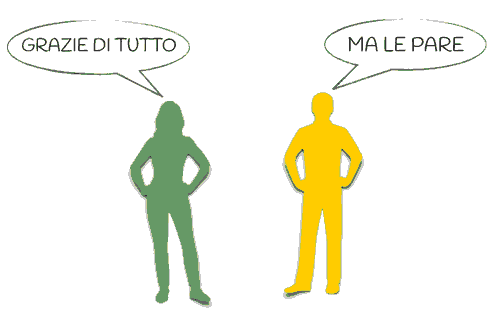Learning to say “thank you” and answer with expressions of gratitude is an essential element of learning any language or culture.
The skill of thanking and answering in Italian has its own distinct charm and nuances. In this blog article, we go into the lovely world of expressing thanks in Italian and learn how to answer properly.
This guide will help you go through the world of “grazie” (thank you) whether you’re planning a holiday to Italy or simply want to bring a touch of Italian manners into your conversations.
Expressing thanks in Italian would differ in a number of situations. Whether you need to say it friend or to a colleague.
How do native speakers say thank you in Italian?
INFORMAL -> If you want to express your gratitude to a friend or family member, there are many friendly and informal ways to do so.
FORMAL -> If you ever find yourself in a professional environment, such as a workplace where you are unfamiliar with the people present.
Here are some ways to say “thank you” in both informal and formal contexts:
How To Thank you
When expressing gratitude, it’s important to follow these guidelines, so you can effectively and sincerely show your appreciation.
🇮🇹 GRAZIE
🇬🇧 (thank you)
🇮🇹 GRAZIE MILLE
🇬🇧 Thank you a thousand – mille = thousand)
🇮🇹 GRAZIE MOLTE
🇬🇧 (Thank you really much)
🇮🇹 MOLTE GRAZIE
🇬🇧 (Thank you really much)
🇮🇹 GRAZIE TANTO/TANTE
🇬🇧 (Thanks a lot)
🇮🇹 GRAZIE DAVVERO
🇬🇧 (Thank you really)
🇮🇹 GRAZIE INFINITE
🇬🇧 (Thank you really much – infinite = infinite, endless)
🇮🇹 GRAZIE DI CUORE
🇬🇧 (Thanks from the bottom of my heart)
🇮🇹 GRAZIE DI TUTTO
🇬🇧 (Thanks of everything)
🇮🇹 GRAZIE, MOLTO GENTILE
🇬🇧 (Thanks, you are very courteous)
🇮🇹 GRAZIE PER … (essere qui/essere venuto/avermi aiutato, ecc)
🇬🇧 (Thanks for … )
🇮🇹 GRAZIE LO STESSO
🇬🇧 (Thanks anyway)
This is what you’d say if you were ending a conversation and then saying thank you at the end of it, indicating that you didn’t really get what you wanted/were looking for, but are thanking them for trying.
❗️INFORMAL
🇮🇹 TI RINGRAZIO
🇬🇧 (I thank you – 2nd person singular, this is only INFORMAL)
❗️ FORMAL
🇮🇹 LA RINGRAZIO
🇬🇧 (I thank you – 2nd person singular, this is only FORMAL)
It’s always nice to give a polite reply in return when someone thanks you.
Depending on the situation and the relationship between both people involved, this can be used in both formal and informal circumstances.
How To Reply To a Thank You
🇮🇹 PREGO
🇬🇧 (You are welcome )
🇮🇹 DI NIENTE
🇬🇧 (It’s all right)
🇮🇹 DI NULLA
🇬🇧 (It’s all right)
🇮🇹 NON C’E’ DI CHE
🇬🇧 (It’s all right)
🇮🇹 NESSUN PROBLEMA
🇬🇧 (No problem)
🇮🇹 E’ UN PIACERE
🇬🇧 (it’s a pleasure)
🇮🇹 E’ STATO UN PIACERE
🇬🇧 (it was a pleasure)
❗️INFORMAL
🇮🇹 MA TI PARE
🇬🇧 (Don’t mention it!)
this is only INFORMAL
🇮🇹 FIUGùRATI
🇬🇧 (It’s all right)
this is only INFORMAL
FORMAL
🇮🇹 MA LE PARE
🇬🇧 (Don’t mention it!)
this is only FORMAL
🇮🇹 SI FIGùRI
🇬🇧 (It’s all right)
this is only FORMAL
🇮🇹 SI IMMAGINI
🇬🇧 (It’s all right – FORMAL)
this is only FORMAL



Culture Hint
In Italy, expressing appreciation is sincere behaviour, and acknowledging it in kind is appreciated. It’s usual to use expressions like “grazie mille” and “di niente” to express gratitude, and it’s good to respond with a sincere smile or nod.
Understanding how to give thanks and respond to gratitude is a useful ability, whether you’re visiting Italy or communicating with Italian speakers in your area.
It not only improves your language skills but also makes it possible for you to establish sincere relationships with others. Therefore, remember how to say “grazie” to people when you need it.
What’s next?
You might want to keep learning Italian online with these free resources:










Leave a Reply